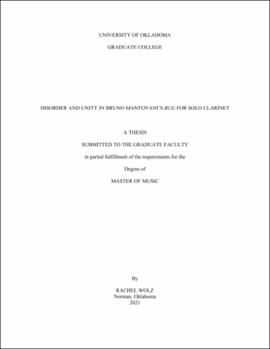| dc.description.abstract | Bruno Mantovani’s Bug (1999) for solo clarinet is a musical metaphor that depicts the disarray and disorientation caused by an imaginary computer malfunction. Historically, this piece parallels the anxiety surrounding the uncertainty of Y2K. The density of the musical material often makes this piece difficult to categorize and conceptualize. He divides the piece into a clear bipartite design, utilizes different durational patterns, juxtaposes regular and irregular rhythms, develops motives throughout all sections, and transforms pitch-class sets to ultimately give both the listener and the performer on a sense inconsistent time. While the material creates disorder, Mantovani also highlights cohesion through his pitch-class set and motivic unity. Bug is a rich and dynamic piece of contemporary music that can be conceptualized through an analysis of pulse, rhythm, pitch, and motive, to ultimately reveal how Mantovani alters our perception of time and creates overall coherence.
Mantovani sets the rhythmic framework of the piece through two primary motives; motive X and motive Y. Motive X is defined through its three sixteenth-note grouping. Motive Y is defined through its dotted eighth note with a trill and quarter note with a bisbigliando. Each motive is varied to different degrees throughout the work.
One of the biggest ways Mantovani plays upon our conception of time is through rhythm and pulse. Bug is written with an absence of time signature and bar lines, making pulse and meter difficult to understand. There are two major aspects I consider about rhythm: how Mantovani creates different pulses and how the interaction of multiple pulses cause conflict in our perception of time. Mantovani sets up most of the rhythmic activity of the piece through the grouping of a rhythmic duration—three sixteenth notes. This is established from the start as three separate, articulated entities, which further develops into a series of different rhythmic permutations. Mantovani then sets up the rest of the piece through relationships between these rhythmic durations, varying ideas through augmentation, and diminution, and ultimately creating conflict through juxtapositions of different pulses.
Bug also gains coherence by the repetition and variation of pitch collections and motives. There are three important pitch collections that are central to the work; (026), the major third, and the tritone. Each collection is used throughout sections to create a sense of unity. He also develops primary motives to create cohesion throughout phrases and across large sections.
As the thesis reveals, Bug is a vigorous and virtuosic contemporary work that can be understood through the analysis of form, understanding of relationships between rhythmic durations, and motivic development. Through his use of rhythm and harmonic language, Mantovani reflects on the societal preoccupation with time at the during the end of the 20th century, resulting in a piece centered around controlling our sense of time. | en_US |
